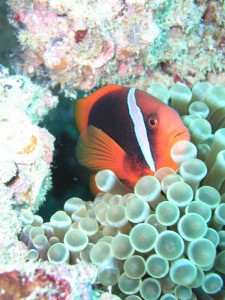Author: Jennifer Cheong, MBA Office

Pulau Redang is one of the largest islands located off the east coast of Malaysia in the state of Terengganu. The area is a conserved marine park ideal for snorkeling and scuba-diving activities. Redang was used as the backdrop for a Hong Kong summer holiday movie – Xia Re Mo Mo Cha in 1999. Ever since the movie was screened in Asia, the pristine warm white sandsand mesmerizing turquoise sea has beckoned many to the island. From Singapore, the island is easily accessible via an affordable overnight coach ride.
There is a wide range of accommodation from budget to four-star hotels. Most are located at Pasir Panjang beach and a handful at Teluk Kalong. Only Berjaya Resort has its own private beach. All the resorts in Redang offer all-inclusive package holidays which include boat transfers, accommodation, snorkeling or diving & meals. These can be arranged directly with the resort of your choice. Meals provided at the resorts are often local dishes served buffet style. If these do not suit your taste, you can always try one of the restaurants at a neighboring resort for a western style burger or go for a more authentic taste of nasi goreng kampung (fried Malay rice with anchovies).
Redang is a small tropical island good for a weekend getaway. Most choose to spend their days idyllically napping away in a swaying hammock or revel under the sun for a nice golden tan. You can also join one of the snorkeling trips organized by your resort. However, you can also choose to just snorkel at the shallow reefs of Pasir Panjang which can already give you a glimpse of the rich ocean life of Redang.
For the restless at heart, you can opt to try a Discover Scuba for non-divers during your trip. This will be an instructor-guided dive where you will be introduced to the basics of diving and have a taste of the underwater world. It is usually a short half day session and allows you a preview of the colourful tropic reefs.
Those determined to add a PADI scuba-diving license on top of achieving a prestigious MBA degree in Asia, an open-water course can be done with any of the dive centers in Redang. The open-water course teaches you the foundations of diving with both theory and practical tests. This can be done within 4 – 5 days at the resort dive center depending on the aptitude of the student. Do note that an open water course (equipment rental inclusive) with full-board resort stay cost about SGD 500 – 800.
What does the underwater world in Redang have to offer? One can often spot reef sharks, beautiful corals, stingrays, barracudas and many fascinating ocean life in the Redang waters. Occasionally, lucky divers may even get to spot whale sharks on their migratory routes! Redang also has an important conservation site for turtles which include the Green Turtle and Hawksbill Turtle. Turtle or wildlife lovers can even sign up at the conservation website to serve as a volunteer. By the way, visit first Singapore’s world-renowned Underwater World at Sentosa too! These two locations offer different experiences despite offering similar things!
Meeting Nemo face to face can be an interesting encounter. Watching a swift reef shark majestically gliding through the waters can be a humbling experience. Weaving through a vibrant forest of corals can be a bewitching memory. All these with just a bold plunge into a whole new world beneath the waters. So head off to Redang in your next break and enrich your knowledge of a secret world hidden away.

Getting There:
Berjaya Air flies to Pulau Redang direct from Singapore. (www.berjaya-air.com) Return airfare is
as low as SGD 170 including taxes. The flight takes only 1 hr 20 mins.
For a more budget option, Konsortium and Five Star coaches can drop you at Merang Jetty (Note: not to be confused with Marang Jetty). From the jetty, board the boat transfer arranged with the resort. Return coach fare is as low as SGD 90. About 12 hours ride overnight.
For more information on Redang resorts: http://redang.org/resorts.htm













You must be logged in to post a comment.